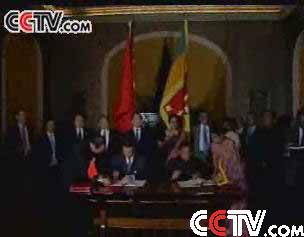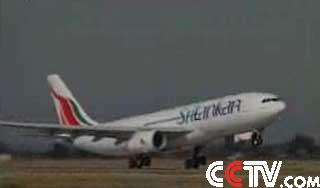Source: CCTV.com
02-28-2007 09:46
Sri Lanka's development and its relations with China
 |
The streets of Colombo proclaim "China is our true friend forever."
In 1952, the two countries signed the Rubber-Rice Pact, in which China sold rice to Sri Lanka in exchange for rubber. It was China's first trade agreement with a non-Communist country.
In 1957, the two countries established embassies in each other's capitals.
That same year, Premier Zhou Enlai visited Sri Lanka, and again in 1964.
Sri Lankan President Mahinda Rajapaksa said, " In both countries, the Buddhist influence has dominated their cultural and
social fabric of the society which is clearly visible even today. This has laid a solid foundation for the Sri Lanka-China relations in the cultural, historical, social and economic arenas."
China helped build a number of projects in Colombo, such as the High Court and the Bandaranaike Memorial International Conference Hall.
The hall, built in the 1970s, is regarded as a symbol of Sino-Sri Lankan friendship.
Dr. Hao Weimin, Senior Lecturer of Sabaragamuwa University of Sri Lanka, said, "For the past fifty years, China gave a lot of assistance to Sri Lanka. The assistance promoted the development of Sri Lankas' frastructure construction. Frequent political exchanges of the two nations brought the relationship into an all round way including politics, economy, tourism and education."
In December 2004, a massive tsunami struck Sri Lanka, killing over 30,000 people.
China was among the first countries to respond with assistance, helping to rebuild the Sri Lanka Fishery Harbors.
In April 2005, in Colombo, Wen Jiabao and Sri Lankan President Chandrika Bandaranaike Kumaratunga witnessed the signing of an Agreement for the Further Strengthening of Economic Relations.
In August that year, Kumaratunga paid a state visit to China. The two nations signed cooperation agreements on trade, tourism, culture and education.
In the political sector, Sri Lanka supports the one-China principle. While China has supported Sri Lanka in its efforts to safeguard its sovereignty and development.
Economic performance in Sri Lanka
 |
The island nation of Sri Lanka has undergone significant changes in the 59 years since it emerged from colonial rule as an independent nation. Its transition to a market economy began 1979 with a series of structural reforms. Since then its development has evolved with the country enjoying strong economic growth.
The target for growth in 2007, is set by the government in Colombo at nearly eight percent.
Colombo is concentrating on ways to boost the national economy for 2007 with particular focus on raising per capita income.
Sri Lankan President Mahinda Rajapaksa said, "This government has introduced a 10-year development plan to usher in a new era for all Sri Lankans. The aimed is to invigorate our economy and put the country on a strong economic footing. Our plan has led to an economic renaissance with a focus on agriculture, industries and service sectors."
The Government is investing billions of rupees in the massive Weerawila Airport Development Project and several main highway development projects.
Sri Lanka has recorded its highest Gross Domestic Product(GDP) rate with a 7.4 percent performance in the third quarter of 2006.
Sri Lankan President Rajapaksa said, "At the same time, the industries sector was given prime place to enable the country to increase production, with the help of investments into new industries. For that, we are focusing primarily on infrastructure facilities such as roads and ports, electricity, telecommunication and service sectors."
In the agriculture sector, there has been a 5.7 percent increase.
The sub sector of total industry grew by 7.9 percent.
And the growth in the total services sub sector grew to 7.6 percent in the third quarter of 2006.
The Director General of Census and Statistics identifies four main reasons for the growth.
First, favorable government economic policies.
Second, weather conditions during the first three months of 2006 which benefitted agriculture and hydropower generation.
Third, an uninterrupted power supply and distribution.
Fourth and last, the satisfactory economic performance of countries like the US and Japan, and the European Union.
The government has supported farmers with a fertilizer subsidy and favorable market policies, which include reasonable import duties on certain commodities.
Editor:Liu Fang
